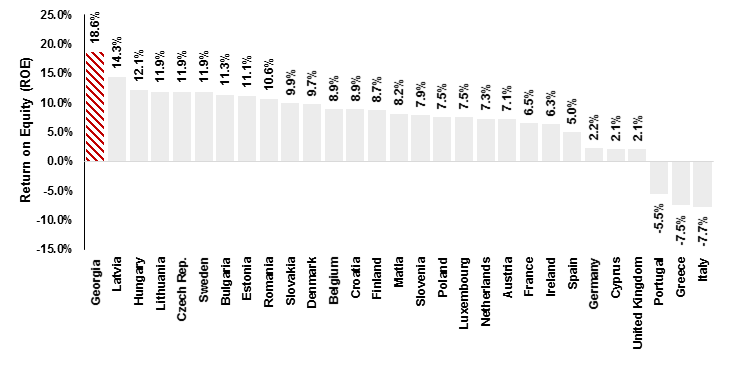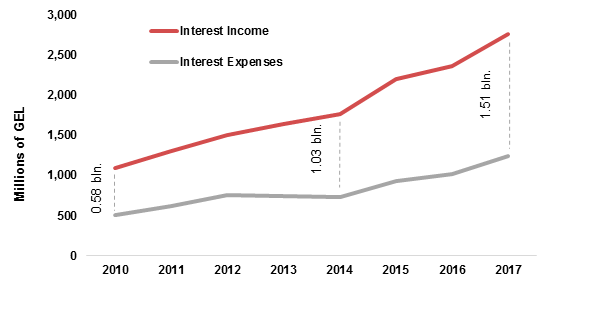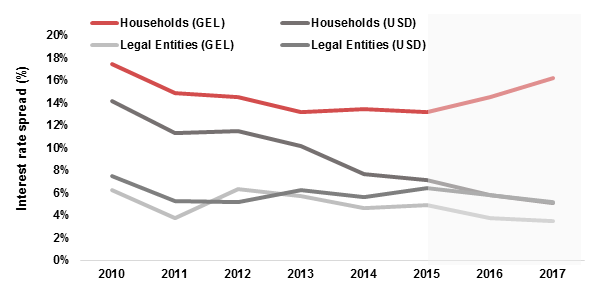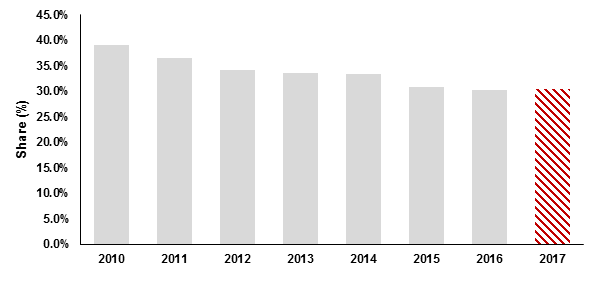 10
July
2023
10
July
2023
ISET Economist Blog
 Monday,
12
February,
2018
Monday,
12
February,
2018

Interest in bank profitability is increasing every year. Google search data for Georgia shows that in 2017, there were 4,700 pieces (articles, blogs, comments, and other documents) found for “Banks’ Profit” (ბანკების მოგება) while the same indicator in 2016 amounted to merely 2,990 pieces. In 2015, it was even smaller – 2,160 pieces. This growing interest has its own objective reason, which is simple: In 2017, compared to the previous year, profits for commercial banks increased dramatically by 190 mln. GEL (if you like percentages, it is 28%), and amounted to 869 mln. GEL. This amount of profit is about the same as the budget of the Ministry of Finance (82 mln. GEL1), plus the budget of the Ministry of Justice (63 mln. GEL), plus the budget of the Ministry of Foreign Affairs (120 mln. GEL), plus the budget of the Ministry of Internal Affairs (570 mln. GEL), plus the budget of the Government Administration (16 mln. GEL), plus the budget of the President’s Administration (10 mln. GEL). If you are more familiar with sports, in particular football transfers, Georgian bank profit is a bit lower than the transfer price of Neymar (670 mln. GEL) and the transfer price of Coutinho (330 mln. GEL) combined.
The volume of Georgian banks’ profit looks really impressive, but to evaluate how big or small it is, some benchmark indicators are needed. One of the most used indicators is Return on Equity (ROE). By definition, ROE is a measure of companies’ profitability which demonstrates how much profit a company generates for each GEL of shareholders’ equity.
But why does ROE matter? In principle, ROE measures not only profitability but also reflects the efficiency of the company. Higher ROE indicates how efficiently the company management uses shareholders’ capital. At the same time, ROE is a key indicator to assess company attractiveness to investors.
After getting familiar with the ROE, let’s do what all Georgians and at the same time all economists love – a comparison with other countries.
Graph #1. Return on Equity (ROE) of Commercial Banks, 2016

Can you notice any association with the European Union? Congratulations! Georgia takes the first position in comparison with EU countries. In 2016, ROE was the highest in Georgia (18.6%), followed by Latvia (14.3%) and Hungary (12.1%). The least profitable banks are in Portugal, Greece, and Italy. In 2017, ROE in Georgia was even higher and amounted to 24.6% on average. This is a historical maximum for the Georgian banking industry.
If we compare Georgia to our “model country,” Estonia, the difference is noticeable as well. For Estonian banks, ROE amounts to 11.1%. Because of low-interest rates (business loans – 2.2%, household loans – 4.7%2), profitability becomes a key challenge faced by Estonian banks. (The profitability of the Georgian banking sector gives us the idea of sharing our success story with our Estonian friends.)
In general, the high profitability of one of the economic sectors of a country seems to be positive for the whole economy, but when we are talking about the banking industry, the topic is much more sensitive and complicated and raises many questions.
The possible links between bank profitability and economic growth make this topic more important not only for academics but for central banks as well. There are two contradictory arguments as to how bank profits affect economic growth. One is that high profitability is associated with low competition/high concentration, which leads to constrained access to credit and therefore hampers overall economic growth (Beck et al. (2004), Catorelli and Gambera (2004)). On the other hand, bank profitability can foster financial stability and positively influence economic growth. Furthermore, high bank profitability might reduce the probability of bank failure (Claeys and Schoors (2007)).
Now, let’s go back to the Georgian case. To shed some light on how banks generate profit, an investigation into banks' income and expense structure is needed. In general, profit is just net income, calculated using the following formula:
Profit = Income (Interest + Non-interest) – Expenses (Interest + Non-interest)
Taking into account the fact that the banking industry mostly deals with lending and borrowing, interest income (77% of total income) and interest expenses (48% of total expenses) contribute the most to total profit generation.
Graph #2. Interest Income vs. Interest Expenses

Graph #2 above shows how the gap between interest income and interest expenses has been increasing over time, meaning that interest income increases faster than interest expenses. For instance, in 2010, interest income exceeded interest expenses by only 0.58 bln. GEL, while the latest data in 2017 shows that this gap reached 1.51 bln. GEL.
The reasons for the difference between interest income and interest expenses should be explored through interest rates themselves, particularly the gap between loans and deposit interest rates, known as the interest rate spread (IRS). The difference between these two interest rates is like “mark-up” which reflects the market structure (concentration), riskiness, and efficiency of the banking sector. A high IRS is a sign of an unhealthy environment in financial intermediation, which hampers access to finance and a country’s economic development.
Graph #3. Interest rate spreads for different categories

Not surprisingly, the interest rate spreads are positive (interest rate on loans > interest rate on deposits). Fortunately, they are characterized by a decreasing trend, except for the household market (in GEL) over the last two years (Graph #3). The story below provides some insights into the causes of this phenomenon:
• First, keep it in mind that 2016 was the year after the largest depreciation of Georgian currency GEL (-28.5%) since 2015;
• Compared to GEL-denominated loans, USD-denominated loans became more expensive;
• The demand on GEL-denominated loans increased by 13.2% in 2016, which led to an increase in the interest rates on GEL-denominated loans;
• The demand on GEL-denominated loans increased even more, by 90% in 2017, thanks to the new policy which requires that all household loans up to 100,000 GEL must be denominated in GEL;
• Let’s not forget that in 2017, the monetary policy rate increased three times, by +0.25 (in total +0.75), and amounted to 7.25%;
• Thus, in 2017, the interest rate on GEL-denominated loans increased once again;
• Higher demand on GEL-denominated loans increased demand on GEL-dominated deposits, but the interest rates on deposits increased only at the beginning of the year, and quickly stabilized. Therefore, the average interest rate on deposits, compared to the previous year, did not change much. This might be explained by a new initiative of the Ministry of Finance mandating that starting in July 2017, money held by the treasury is to be saved as short-term deposits. This helps commercial banks to maintain liquidity and have relatively cheap resources denominated in GEL.
To summarize, a higher volume of loans denominated in GEL, and at the same time, higher interest rates stimulated higher profits for commercial banks. However, the impact of GEL depreciation on banks' profit generation should be taken into account as well.
Investigation of interest income and interest expenses is just one part of the story. Another challenge for banks is to deal with is non-interest income and non-interest expenses. It is always ambiguous what non-interest income and expenses really mean, thus we shall begin with the definitions.
Non-interest income includes fees and commissions, income on fines/penalties, net gains/losses from currency conversion operations, net gains/losses from securities trading, and other non-interest income. Even more interesting are non-interest expenses, which cover personnel expenses, fixed assets and inventory expenses, and other miscellaneous expenses. Non-interest expenses can be viewed as a reflection of the quality of bank management (Athanasoglou et al. (2005), Curak (2011)). The ratio of non-interest expenses to total income shows how effectively banks use labor and physical capital. In 2010, the share of Georgian banks’ non-interest expenses relative to total income was around 40%, while in 2017, this indicator amounted to only 30.4%. The decreasing trend of non-interest expenses/total income reflects the productivity/efficiency growth of the commercial banks and therefore contributes to the overall profitability of the banking sector.
Graph #4. The ratio between non-interest expenses to total income

In conclusion, the banking sector’s 869 mln. GEL profit may need further detailed analysis, but we hope this article provided some insights into bank profit generation otherwise google search statistics for “Banks’ Profit” in 2018 will have to increase further.
1 State Budget of Georgia in 2018
2 National Bank of Estonia, 2017





